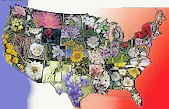
Connecticut Symbols
Connecticut State Flower
Mountain Laurel

(Kalmia latifolia)
Adopted on April 17, 1907.
Designated as Connecticut State Flower by the General Assembly in 1907, the Mountain Laurel, (Kalmia latifolia,) also called ivybush, calico bush, sheep laurel, lambkill, clamoun, and spoonwood is perhaps the most beautiful of native American shrubs. Its fragrance and the massed richness of its white and pink blossoms so vividly contrast with the darker colors of the forests and the fields that they have continually attracted the attention of travelers since the earliest days of our colonization. First mentioned in John Smith's "General History," in 1624 specimens were sent to Linnaeus, the famous botanist, by the Swedish explorer Peter Kalm in 1750.
Connecticut State Flower: Mountain Laurel

Linnaeus gave it the name of Kalmia latifolia, honoring the name his correspondent and at the same time describing the "wide-leafed" characteristic of the plant. In addition to being called the "Mountain Laurel," the plant has also been spoken of as "Calico Bush" and "Spoonwood."
Mountain Laurel is ideally suited as a landscape accent, informal hedge or border where its flowers can be enjoyed. It is best for natural landscapes and other low-maintenance gardens where it can be allowed to grow to its natural size. Grows 4-6" per year.
Identification of the Mountain Laurel
- Leaf: Alternate, simple, evergreen, shiny/waxy above, light green below, 2 to 5 inches long, elliptical in shape, mid-vein raised on upper surfaces.
- Flower: Very showy clusters, white to rose colored with purple markings, 1 inch across, with the petals forming a distinct firm bowl about the pistil and stamens. Present March to July.
- Fruit: A round, brown dehiscent capsule, 1/4 inch long, splitting into 5 valves when dry; releasing very small seeds. Maturing in September and October.
- Twig: Generally forked and twisted, green when young, later brownish-red.
- Bark: Thin, dark brown to red in color, shredding.
- Form: A small tree or shrub with many twisted stems.
The General Statutes of Connecticut
The law designating the mountain laurel as the official Connecticut state flower is found in The General Statutes of Connecticut, Title 3, Chapter 3, Section 3-108.
TITLE 3 - STATE ELECTIVE OFFICERS.
CHAPTER 3 - SECRETARY.
SECTION 3-108.
Sec. 3-108. State flower. The mountain laurel, Kalmia latifolia, shall be the state flower.
(1949 Rev., S. 3582.)
Taxonomic Hierarchy: Mountain Laurel
Kingdom: Plantae - Plants
Subkingdom: Tracheobionta - Vascular plants
Superdivision: Spermatophyta - Seed plants
Division: Magnoliophyta - Flowering plants
Class: Magnoliopsida - Dicotyledons
Subclass: Dilleniidae
Order: Ericales
Family: Ericaceae - Heath family
Genus: Kalmia L. - laurel
Species: Kalmia latifolia L. - mountain laurel
State Floral Emblems







